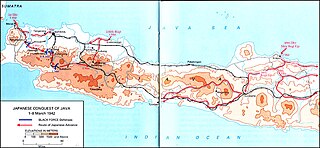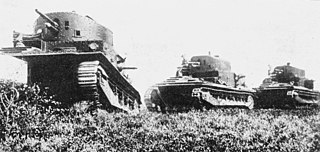A division is a large military unit or formation, usually consisting of between 6,000 and 25,000 soldiers. In most armies, a division is composed of several regiments or brigades; in turn, several divisions typically make up a corps.

Operation Compass was the first large British military operation of the Western Desert Campaign (1940–1943) during the Second World War. British, Empire and Commonwealth forces attacked Italian forces of the 10th Army in western Egypt and Cyrenaica, the eastern province of Libya, from December 1940 to February 1941.

The 5th Canadian Division is a formation of the Canadian Army responsible for the command and mobilization of most army units in the provinces of New Brunswick, Nova Scotia, Prince Edward Island and Newfoundland and Labrador; as well as some units in Kingston, Ontario. The division is recognized by the distinctive maroon patch worn on the sleeve of its soldiers.

The Land Component, historically and commonly still referred to as the Belgian Army, is the land branch of the Belgian Armed Forces. The King of the Belgians is the commander in chief. The current chief of staff of the Land Component is Major-General Jean-Pol Baugnée.

The Battle of Mokra took place on 1 September 1939 near the village of Mokra, 5 km north of Kłobuck and 23 km north-west of Częstochowa, Poland. It was one of the first battles of the Invasion of Poland, during the Second World War, and was one of the few Polish victories of that campaign and the first German defeat of the conflict.
The 10th Army was a field army of the Royal Italian Army, which fought in World War I and in Italian North Africa during World War II.

The 1st Cavalry Division was a regular Division of the British Army during the First World War where it fought on the Western Front. During the Second World War it was a first line formation, formed from Yeomanry Regiments. It fought in the Middle East before being converted to the 10th Armoured Division.

The 19th Alberta Dragoons was a cavalry regiment and later an armoured regiment of the Canadian Militia and later the Canadian Army. It was placed on the Supplementary Order of Battle in 1965. In 2006, it was taken off the Supplementary Order of Battle and amalgamated with the South Alberta Light Horse.

The Battle of Java was a battle of the Pacific theatre of World War II. It occurred on the island of Java from 28 February – 12 March 1942. It involved forces from the Empire of Japan, which invaded on 28 February 1942, and Allied personnel. Allied commanders signed a formal surrender at Japanese headquarters at Bandung on 12 March.
The Order of battle of the East African campaign shows the ground forces of both sides in East Africa on the date that the Italians declared war on Britain and France, 10 June 1940 and for the British and Commonwealth forces involved in the 1941 offensive.

The action at Mechili was an engagement between units of the British 7th Armoured Division of the Western Desert Force and Italian forces of the 10th Army during Operation Compass.

The Experimental Mechanized Force (EMF) was a brigade-sized formation of the British Army. It was officially formed on 1 May 1927 to investigate and develop the techniques and equipment required for armoured warfare and was the first armoured formation of its kind in the world. It was renamed the Armoured Force the following year. The Royal Air Force (RAF) took part in the exercises and demonstrated the value of ground–air co-operation.

133rd Armored Division "Littorio" was an armored division of the Royal Italian Army during World War II. The division's name derives from the fasces carried by the lictors of ancient Rome, which Benito Mussolini had adopted as symbol of state-power of the fascist regime. Sent to North Africa in January 1942 for the Western Desert Campaign the division was destroyed in the Second battle of El Alamein in November 1942.
The 1st Division was one of the three Estonian divisions created during the Estonian War of Independence, which was active until the Soviet occupation of Estonia. Since the restoration of independence in 1991 there are no divisions currently among the Estonian Defence Forces.

In the Battle of Hohenlinden on 3 December 1800, a French army commanded by Jean Victor Marie Moreau decisively defeated the army of Habsburg monarchy led by Archduke John. The first action of the campaign was the Battle of Ampfing, two days earlier. After Hohenlinden there was a series of rearguard clashes beginning on 9 December at Rosenheim and continuing from the 14th through the 20th at Salzburg, Neumarkt am Wallersee, Frankenmarkt, Schwanenstadt, Vöcklabruck, Lambach, and Kremsmünster. During the retreat, the Habsburg army began a process of disintegration and an armistice was concluded a few days later.

The Action at Bir el Gubi took place on 19 November 1941 near Biʾr al-Ġubbiyy, Libya. It was one of the opening engagements of Operation Crusader in North Africa and resulted in a success for the Italian armoured forces.
Reconnaissance regiment in Japanese language, was the type of the military establishment within Imperial Japanese Army in the 1940-1945 period. Reconnaissance regiment was the type of unit derived from Cavalry regiment, tasked with combat scouting. In Japanese military literature reconnaissance regiment is usually abbreviated by SO letters. These regiments were attached to the large number of the Japanese division at the opening stages of the Pacific War. In modern Japan, these regiments are equivalent to Reconnaissance battalion in the divisions of the Japan Ground Self-Defense Force.

The British capture of Tobruk was a battle fought between 21 and 22 January 1941, as part of Operation Compass, the first offensive of the Western Desert Force (WDF) in the Western Desert Campaign of the Second World War. After defeating the Italians in the Battle of Bardia, the 6th Australian Division and the 7th Armoured Division pressed on and made contact with the Italian garrison in Tobruk on 6 January.
















